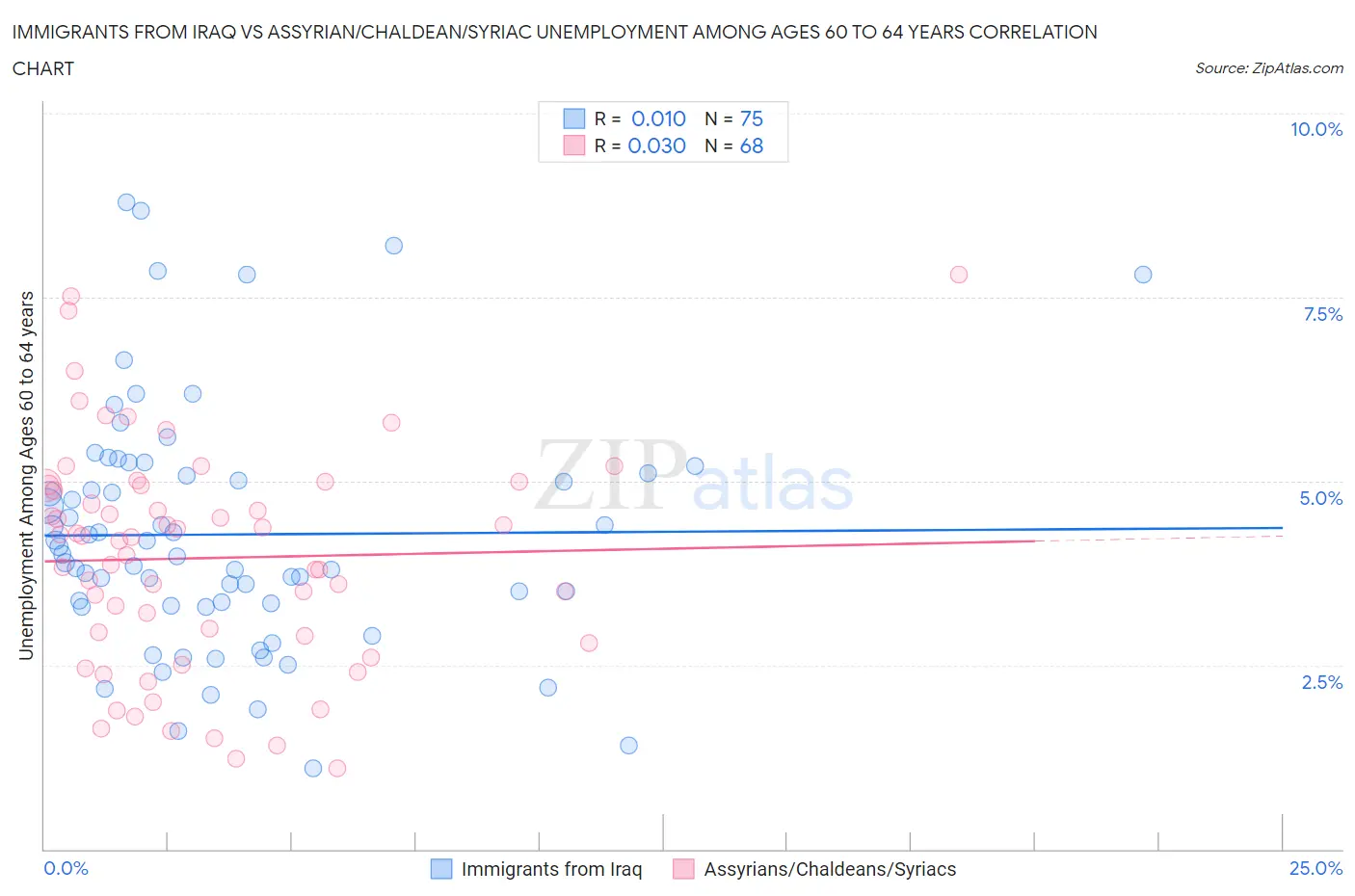Immigrants from Iraq vs Assyrian/Chaldean/Syriac Unemployment Among Ages 60 to 64 years
COMPARE
Immigrants from Iraq
Assyrian/Chaldean/Syriac
Unemployment Among Ages 60 to 64 years
Unemployment Among Ages 60 to 64 years Comparison
Immigrants from Iraq
Assyrians/Chaldeans/Syriacs
4.5%
UNEMPLOYMENT AMONG AGES 60 TO 64 YEARS
100.0/ 100
METRIC RATING
27th/ 347
METRIC RANK
4.5%
UNEMPLOYMENT AMONG AGES 60 TO 64 YEARS
99.9/ 100
METRIC RATING
47th/ 347
METRIC RANK
Immigrants from Iraq vs Assyrian/Chaldean/Syriac Unemployment Among Ages 60 to 64 years Correlation Chart
The statistical analysis conducted on geographies consisting of 186,153,445 people shows no correlation between the proportion of Immigrants from Iraq and unemployment rate among population between the ages 60 and 64 in the United States with a correlation coefficient (R) of 0.010 and weighted average of 4.5%. Similarly, the statistical analysis conducted on geographies consisting of 107,458,902 people shows no correlation between the proportion of Assyrians/Chaldeans/Syriacs and unemployment rate among population between the ages 60 and 64 in the United States with a correlation coefficient (R) of 0.030 and weighted average of 4.5%, a difference of 2.1%.

Unemployment Among Ages 60 to 64 years Correlation Summary
| Measurement | Immigrants from Iraq | Assyrian/Chaldean/Syriac |
| Minimum | 1.1% | 1.1% |
| Maximum | 8.8% | 7.8% |
| Range | 7.7% | 6.7% |
| Mean | 4.3% | 4.0% |
| Median | 4.0% | 4.2% |
| Interquartile 25% (IQ1) | 3.3% | 2.9% |
| Interquartile 75% (IQ3) | 5.1% | 4.9% |
| Interquartile Range (IQR) | 1.8% | 2.1% |
| Standard Deviation (Sample) | 1.7% | 1.5% |
| Standard Deviation (Population) | 1.6% | 1.5% |
Demographics Similar to Immigrants from Iraq and Assyrians/Chaldeans/Syriacs by Unemployment Among Ages 60 to 64 years
In terms of unemployment among ages 60 to 64 years, the demographic groups most similar to Immigrants from Iraq are Immigrants from Nepal (4.5%, a difference of 0.070%), Cuban (4.5%, a difference of 0.31%), Immigrants from Venezuela (4.5%, a difference of 0.33%), Immigrants from Eritrea (4.5%, a difference of 0.40%), and Zimbabwean (4.5%, a difference of 0.44%). Similarly, the demographic groups most similar to Assyrians/Chaldeans/Syriacs are Bhutanese (4.5%, a difference of 0.19%), Liberian (4.5%, a difference of 0.27%), European (4.5%, a difference of 0.50%), Swedish (4.5%, a difference of 0.56%), and English (4.5%, a difference of 0.73%).
| Demographics | Rating | Rank | Unemployment Among Ages 60 to 64 years |
| Immigrants | Iraq | 100.0 /100 | #27 | Exceptional 4.5% |
| Immigrants | Nepal | 100.0 /100 | #28 | Exceptional 4.5% |
| Cubans | 100.0 /100 | #29 | Exceptional 4.5% |
| Immigrants | Venezuela | 100.0 /100 | #30 | Exceptional 4.5% |
| Immigrants | Eritrea | 100.0 /100 | #31 | Exceptional 4.5% |
| Zimbabweans | 100.0 /100 | #32 | Exceptional 4.5% |
| Carpatho Rusyns | 100.0 /100 | #33 | Exceptional 4.5% |
| Belgians | 100.0 /100 | #34 | Exceptional 4.5% |
| Germans | 100.0 /100 | #35 | Exceptional 4.5% |
| Venezuelans | 100.0 /100 | #36 | Exceptional 4.5% |
| Immigrants | Portugal | 100.0 /100 | #37 | Exceptional 4.5% |
| Native Hawaiians | 100.0 /100 | #38 | Exceptional 4.5% |
| Iraqis | 100.0 /100 | #39 | Exceptional 4.5% |
| Scandinavians | 100.0 /100 | #40 | Exceptional 4.5% |
| Immigrants | Sudan | 100.0 /100 | #41 | Exceptional 4.5% |
| English | 100.0 /100 | #42 | Exceptional 4.5% |
| Swedes | 100.0 /100 | #43 | Exceptional 4.5% |
| Europeans | 100.0 /100 | #44 | Exceptional 4.5% |
| Liberians | 99.9 /100 | #45 | Exceptional 4.5% |
| Bhutanese | 99.9 /100 | #46 | Exceptional 4.5% |
| Assyrians/Chaldeans/Syriacs | 99.9 /100 | #47 | Exceptional 4.5% |